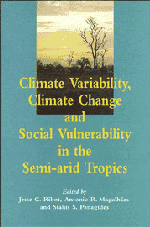Book contents
- Frontmatter
- Contents
- List of contributors
- Foreword by Tom Downing
- Preface
- List of abbreviations
- Introduction. Climate Variability, Climate Change and Vulnerability: Moving Forward by Looking Back
- PART I OVERVIEW
- PART II CLIMATE VARIATION, CLIMATE CHANGE AND SOCIETY
- 2 Climate Change and Variability in Mexico
- 3 The Impact of Climate Variation and Sustainable Development in the Sudano-Sahelian Region
- 4 Climate Change and Sustainable Development in China's Semi-arid Regions
- 5 Settlement Advance and Retreat: A Century of Experience on the Eyre Peninsula of South Australia
- PART III CLIMATE VARIABILITY AND VULNERABILITY: CAUSALITY AND RESPONSE
- PART IV THE INTERNATIONAL CONFERENCE ON THE IMPACTS OF CLIMATIC VARIATIONS AND SUSTAINABLE DEVELOPMENT IN SEMI-ARID REGIONS (ICID)
2 - Climate Change and Variability in Mexico
Published online by Cambridge University Press: 02 December 2009
- Frontmatter
- Contents
- List of contributors
- Foreword by Tom Downing
- Preface
- List of abbreviations
- Introduction. Climate Variability, Climate Change and Vulnerability: Moving Forward by Looking Back
- PART I OVERVIEW
- PART II CLIMATE VARIATION, CLIMATE CHANGE AND SOCIETY
- 2 Climate Change and Variability in Mexico
- 3 The Impact of Climate Variation and Sustainable Development in the Sudano-Sahelian Region
- 4 Climate Change and Sustainable Development in China's Semi-arid Regions
- 5 Settlement Advance and Retreat: A Century of Experience on the Eyre Peninsula of South Australia
- PART III CLIMATE VARIABILITY AND VULNERABILITY: CAUSALITY AND RESPONSE
- PART IV THE INTERNATIONAL CONFERENCE ON THE IMPACTS OF CLIMATIC VARIATIONS AND SUSTAINABLE DEVELOPMENT IN SEMI-ARID REGIONS (ICID)
Summary
INTRODUCTION
Mexico, located between latitudes 15° and 32°N, spans a range of climates from arid desert to the humid tropics (Fig. 1). There is a significant geographic mismatch between water and human occupancy in Mexico. Seven percent of the land, lying in the extreme southeast of the country, receives 40% of the rainfall. Only 12% of the nation's water is on the central plateau where 60% of the population – including the 18 million people who live in Mexico City – and 51 % of the cropland are located. Of Mexico's 195 million hectares (m ha) of land, only 15% is classified as humid or very humid; the remaining 85% is semi-arid, arid, or very arid (Table 1). Thus, in most parts of Mexico, human activity relies on the low, seasonal and variable rainfall that characterizes the arid and semi-arid regions of the world.
The dry climates, together with steep topography, are the main reasons why only 16% of Mexico's land area is considered suitable for crop production (Table 2). In contrast, 38% is considered appropriate for pasture. More than one-third of Mexico's rapidly growing population works in agriculture, a sector whose prosperity is critical to the nation's debt-burdened economy and to national self-sufficiency in food.
One-fifth of Mexico's cropland is irrigated and this area accounts for half of the value of the country's agricultural production, including many export crops. Many irrigation districts rely on small reservoirs and wells which deplete rapidly in dry years. The remaining rainfed cropland supports many subsistence farmers and provides much of the domestic food supply.
- Type
- Chapter
- Information
- Publisher: Cambridge University PressPrint publication year: 1996



